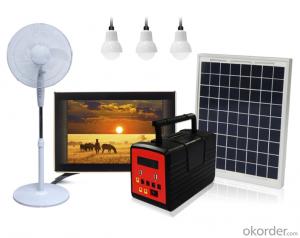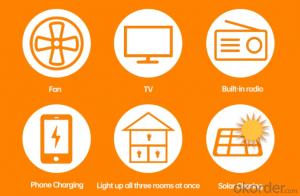Portable Solar Home Energy Power System with Big Solar Panel LED Light Product Radio MP3
- Loading Port:
- Shekou
- Payment Terms:
- TT OR LC
- Min Order Qty:
- 1 set
- Supply Capability:
- 500 set/month
OKorder Service Pledge
OKorder Financial Service
You Might Also Like
Item specifice
1. Description and specifications of Portable Solar Home Energy Power System with Big Solar Panel LED Light Product Radio MP3
Model NO. PS-K025L2
Battery: 11.1V/13000 mAh Li-ion
Bulbs: 3*3W with 5m Cable
Stand Fan: 16 Inch
Function:Lighting, Phone Charging, Radio, MP3, TV, Fan
Charging Time:6-8 H Under Sufficient Sunlight
Working Time: 14h for 3 Lamps; 22h for 2 Lamps; 43h for 1 Lamp
Accessories: 5-in-1 Charging Cable
2. Features of Portable Solar Home Energy Power System with Big Solar Panel LED Light Product Radio MP3
- All-in-1 DIY design, just need to plug & pla
- Multifunctional Lighting & 2 USB phone charger & TV & DC ceiling fan & FM radio and MP3
- 5*DC 12V output for powering different DC appliance
- Lighting up 3 rooms at the same time, max can connect 5 bulbs
- 2 DC Charging input to charge battery, by solar or electricity
- Battery indicator to show battery capacity to remind you charge in time
3. Pictures of Portable Solar Home Energy Power System with Big Solar Panel LED Light Product Radio MP3


4. Packages
Sea transport packages
- Q:Can solar energy systems be used for powering research laboratories or scientific facilities?
- Yes, solar energy systems can definitely be used for powering research laboratories or scientific facilities. In fact, solar energy is becoming increasingly popular in the scientific community due to its numerous benefits. Firstly, solar energy systems are highly reliable and require minimal maintenance. Once installed, they can provide a consistent and uninterrupted power supply to research laboratories or scientific facilities, ensuring that critical operations are not disrupted. This is particularly important for facilities that require continuous power, such as those conducting experiments or running sensitive equipment. Secondly, solar energy is a clean and renewable source of power. By utilizing solar energy systems, research laboratories and scientific facilities can significantly reduce their carbon footprint and contribute to the global effort of combating climate change. This aligns with the scientific community's commitment to sustainability and environmental responsibility. Furthermore, solar energy systems can also help reduce energy costs for research laboratories and scientific facilities. While the initial investment in installing solar panels may be higher, the long-term savings on electricity bills can be substantial. This frees up resources that can be directed towards other important research activities or equipment upgrades. It is also worth mentioning that advancements in solar technology have made it increasingly efficient and capable of generating power even in less sunny areas. This means that research laboratories and scientific facilities located in regions with varying weather conditions can still benefit from solar energy systems. In conclusion, solar energy systems are a viable and advantageous option for powering research laboratories or scientific facilities. They provide reliable, clean, and cost-effective energy, aligning with the sustainability goals of the scientific community. As solar technology continues to improve, it is expected that the use of solar energy in research facilities will become even more widespread.
- Q:What is the difference between solar energy systems and solar panels?
- Solar energy systems and solar panels are interconnected yet distinct entities. The primary constituents of a solar energy system are solar panels. These devices convert sunlight into electricity by utilizing photovoltaic cells. The cells consist of semiconductor materials that generate an electric current upon exposure to sunlight. Multiple solar cells are typically connected to form solar panels, thereby increasing voltage and power output. These panels are often installed on rooftops or in open areas to maximize sunlight absorption. In contrast, a solar energy system comprises more than solely solar panels. It encompasses all the essential components and equipment necessary to effectively harness and utilize solar energy. This includes inverters, which convert the direct current (DC) electricity generated by the solar panels into alternating current (AC) electricity suitable for residential or commercial use. Other components may incorporate batteries for energy storage, charge controllers to regulate electricity flow, and monitoring systems to track the solar energy system's performance. To summarize, solar panels are physical devices that capture sunlight and convert it into electricity, while a solar energy system is a comprehensive setup that integrates solar panels with other vital components to efficiently generate, store, and utilize solar energy.
- Q:How do solar energy systems impact energy independence?
- Solar energy systems can greatly impact energy independence by reducing reliance on traditional energy sources such as fossil fuels. By harnessing the power of the sun, solar energy systems provide a clean and renewable source of electricity. This reduces the need to import energy from other countries, enhancing a nation's energy independence. Additionally, solar energy systems can be installed at individual homes and businesses, allowing individuals to generate their own electricity and become less dependent on the grid. Overall, solar energy systems play a crucial role in promoting energy independence and reducing the carbon footprint.
- Q:How does the installation of solar panels affect the building's resale value?
- The installation of solar panels can have a positive impact on a building's resale value. Solar panels are seen as a valuable addition to a property as they provide several benefits. Firstly, solar panels can significantly reduce or even eliminate electricity bills, which is an attractive feature for potential buyers. The prospect of saving money on energy costs can make a property more appealing and increase its market value. Additionally, with rising concerns about climate change and a growing interest in sustainable living, having solar panels can be seen as a desirable feature that aligns with eco-conscious values. Moreover, solar panels can also generate income through net metering programs. In some regions, excess electricity generated by solar panels can be sold back to the grid, providing an additional revenue stream. This financial benefit can make a property more valuable and attract buyers who are interested in renewable energy investments. Furthermore, the installation of solar panels can contribute to a building's overall energy efficiency. This can lead to improved energy performance ratings and certifications, such as LEED or Energy Star, which can further enhance the property's resale value. However, it is important to note that the impact on resale value may vary depending on various factors, including the location of the property, local housing market trends, and the size and quality of the solar panel system. It is advisable to consult with real estate professionals or appraisers who have experience in evaluating the impact of solar panels on property values in a specific area.
- Q:How does the efficiency of solar panels vary across different installation locations?
- The efficiency of solar panels varies across different installation locations due to various factors such as the amount of sunlight received, the angle and orientation of the panels, shading, temperature, and local weather conditions.
- Q:What is the impact of electromagnetic interference on solar energy system performance?
- Electromagnetic interference can have a negative impact on the performance of solar energy systems. It can cause disruptions and fluctuations in the electrical signals and data transmission within the system, leading to reduced efficiency and reliability. Additionally, electromagnetic interference can interfere with the proper functioning of inverters and other critical components, potentially causing system failures and downtime. Therefore, it is crucial to implement proper shielding and mitigation measures to minimize the impact of electromagnetic interference on solar energy system performance.
- Q:What is the role of solar trackers in maximizing solar energy generation?
- Solar trackers play a crucial role in maximizing solar energy generation by dynamically orienting solar panels to follow the sun's path throughout the day. This constant adjustment ensures that panels receive maximum sunlight exposure, optimizing their energy output. By tracking the sun's movement, solar trackers increase the efficiency of solar panels, resulting in higher energy production and improved overall performance.
- Q:How does a solar panel generate electricity?
- A solar panel generates electricity through the photovoltaic effect, where sunlight is converted into electrical energy. This process occurs when the photons in sunlight strike the solar cells within the panel, causing the electrons in the cells to be excited and flow as an electric current.
- Q:Are there any risks of electromagnetic radiation with solar energy systems?
- Solar energy systems have potential risks related to electromagnetic radiation. These systems utilize photovoltaic panels to convert sunlight into electricity. The panels produce direct current (DC) electricity, which is then changed to alternating current (AC) electricity for use in homes and businesses. One potential source of electromagnetic radiation is the inverter, responsible for converting DC electricity to AC electricity. In some cases, these inverters may generate electromagnetic fields (EMFs) that emit low-frequency radiation. Although these EMFs are generally considered low and within acceptable limits, ongoing research aims to better understand any potential health effects from long-term exposure to these fields. Another risk involves high-frequency electromagnetic radiation from radio frequency (RF) communication devices, like wireless monitoring systems or communication modules used in solar energy systems. These devices wirelessly transmit and receive signals, causing concern about potential health effects from long-term RF radiation exposure. However, these devices typically have low power levels and are designed to comply with safety standards and regulations. It's important to note that the risks associated with electromagnetic radiation from solar energy systems are generally considered low compared to other everyday sources, such as cell phones, Wi-Fi routers, or power lines. Nonetheless, it is always advisable to follow safety guidelines provided by manufacturers and industry standards to minimize potential risks.
- Q:Can solar energy systems be used for lighting outdoor spaces?
- Yes, solar energy systems can be used for lighting outdoor spaces. Solar-powered lights use solar panels to convert sunlight into electricity, which is then stored in batteries and used to power the lights at night. These lights are commonly used in gardens, pathways, parking lots, and other outdoor areas where traditional electrical connections may not be available or practical.
1. Manufacturer Overview |
|
|---|---|
| Location | |
| Year Established | |
| Annual Output Value | |
| Main Markets | |
| Company Certifications | |
2. Manufacturer Certificates |
|
|---|---|
| a) Certification Name | |
| Range | |
| Reference | |
| Validity Period | |
3. Manufacturer Capability |
|
|---|---|
| a)Trade Capacity | |
| Nearest Port | |
| Export Percentage | |
| No.of Employees in Trade Department | |
| Language Spoken: | |
| b)Factory Information | |
| Factory Size: | |
| No. of Production Lines | |
| Contract Manufacturing | |
| Product Price Range | |
Send your message to us
Portable Solar Home Energy Power System with Big Solar Panel LED Light Product Radio MP3
- Loading Port:
- Shekou
- Payment Terms:
- TT OR LC
- Min Order Qty:
- 1 set
- Supply Capability:
- 500 set/month
OKorder Service Pledge
OKorder Financial Service
Similar products
New products
Hot products
Hot Searches
Related keywords































